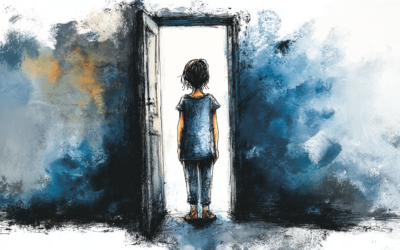Estrangement can feel like a rupture, severing not just the bond with a parent but rippling into other aspects of your life. It can create unintended divides with other family members, echoing the same patterns of disconnection and misunderstanding that caused the original estrangement. These dynamics may leave you asking yourself: Am I doomed to repeat the same mistakes? Can I build relationships that are different from what I experienced?
The answer lies in choice. While you can’t control the choices your parent made or the legacy they passed down, you can choose how you respond to it. You can decide to see things differently, to lead with love instead of fear, and to create a new legacy—one rooted in connection, compassion, and growth.
This article explores how to break free from inherited patterns, heal relationships with others impacted by estrangement, and build a legacy of healing that transforms pain into purpose.
Estrangement and the Ripple Effect
Estrangement rarely exists in isolation. When a relationship with a parent fractures, it often affects other family connections as well. Relatives may feel pressured to “choose sides” or withdraw entirely. Misunderstandings may compound, creating a web of hurt that extends far beyond the original conflict.
These dynamics can leave you feeling further isolated or wondering if disconnection is inevitable. But disconnection is not destiny. While you can’t rewrite your family’s past, you have the power to change how you approach the present.
Choosing to Break the Pattern
Estrangement often stems from cycles of fear, blame, and unhealed pain passed down through generations. Your parent may have carried the wounds of their own upbringing, unconsciously perpetuating those patterns in your relationship.
The key to breaking free is recognizing that you don’t have to carry those patterns forward. You can choose differently.
- See the Cycle Clearly: Reflect on the dynamics in your family. What patterns of behavior—criticism, withdrawal, judgment—might have been passed down? Acknowledge these without judgment.
- Recognize Your Power to Choose: While you may have inherited certain patterns, you are not bound to them. Each moment offers a choice: to react from fear or respond from love.
- Heal Through Awareness: When you notice yourself slipping into old patterns—defensiveness, shutting down, or blaming—pause. Ask yourself: Is this how I want to show up? What would love look like here?
By breaking these cycles, you create space for healthier, more authentic relationships—not only with others but also with yourself.
Healing Relationships with Other Family Members
When estrangement with a parent ripples into relationships with siblings, cousins, or extended family, it can feel like you’re trapped in a web of disconnection. These dynamics are often rooted in misunderstandings, unspoken loyalties, or the fallout of unresolved conflict.
The good news is that healing is possible. With intention and care, you can rebuild or strengthen these relationships—even if they’ve been strained by the larger family dynamics.
Steps to Heal Family Connections
- Acknowledge the Ripple Effect
Family members impacted by estrangement may carry their own pain, confusion, or guilt. Start by recognizing how the larger family dynamic may have affected them, even if they were not directly involved. - Be the Bridge
While you can’t control how others respond, you can take steps to open the door to connection. Reach out with curiosity and compassion, letting them know you value the relationship and are willing to work toward understanding. - Release Assumptions
Estrangement can breed assumptions about how others feel or what they believe. Instead of projecting your fears, ask open-ended questions and truly listen to their perspective. - Set Boundaries with Love
Healing doesn’t mean tolerating harmful behavior. Be clear about what you need to feel safe and respected in the relationship, while also respecting their boundaries. - Offer Forgiveness, Even If It’s Imperfect
Forgiveness doesn’t mean excusing past hurt—it means choosing to release resentment so you can move forward with clarity. Even if the relationship remains complicated, forgiveness allows you to approach it with a lighter heart.
Breaking Free from Fear-Based Patterns
One of the most transformative lessons of healing is realizing that fear is not your only guide. The behaviors that caused estrangement—blame, criticism, avoidance—are often rooted in fear: fear of vulnerability, fear of rejection, fear of not being enough.
When you choose to act from love instead of fear, you create a new foundation for your life. This doesn’t mean ignoring boundaries or denying your emotions—it means responding to challenges with compassion, curiosity, and courage.
How to Act from Love Instead of Fear
- Pause Before Reacting
When conflict arises, give yourself a moment to breathe. Ask: Am I reacting from fear, or responding from love? What would a loving response look like? - Reframe the Situation
Instead of seeing others as attackers or adversaries, try to view them as people carrying their own pain and fears. This doesn’t excuse harmful behavior, but it helps you respond with empathy rather than defensiveness. - Lead with Compassion
Love begins with understanding. Seek to understand others’ perspectives, even if you don’t agree with them. Compassion doesn’t mean compromising your boundaries—it means honoring your humanity and theirs. - Forgive Yourself When You Slip
Breaking old patterns is a process, and you won’t always get it right. When you react out of fear, forgive yourself. Each moment is a new opportunity to choose differently.
Creating a Legacy of Love and Healing
Estrangement may have shaped your story, but it doesn’t have to define your legacy. The life you create—from the relationships you nurture to the way you show up for yourself—can become a testament to your growth and resilience.
How to Build a Legacy of Healing
- Be a Cycle-Breaker
By choosing love over fear, you set a new precedent for how relationships can look in your family. You model what it means to lead with compassion, even in the face of pain. - Live in Alignment with Your Values
Let your values guide your actions, relationships, and choices. Whether it’s kindness, honesty, or creativity, align your life with what matters most to you. - Offer Grace to Yourself and Others
Healing isn’t about perfection—it’s about progress. Offer yourself and others grace as you navigate the complexities of growth and connection. - Cultivate Connection Beyond Your Family
A legacy of love extends beyond your family of origin. Invest in friendships, mentorships, and community relationships that reflect the values and connection you want to build. - Trust in the Abundance of Love
Love is not limited to one person or one relationship. It’s everywhere—within you, in the people who support you, and in the life you’re building. Trust that love is always available, even if it doesn’t come in the form you once expected.
Transforming Pain Into Purpose
Estrangement can feel like a heavy burden, but it can also be a powerful teacher. It shows you where healing is needed, where love is possible, and where growth can happen.
By breaking free from fear-based patterns, fostering meaningful relationships, and leading with love, you create a legacy that transcends pain. You demonstrate to yourself—and others—that healing is not only possible but transformative.
Your legacy begins with every choice you make, every act of compassion you offer, and every moment you choose to see yourself and others through the lens of love.



